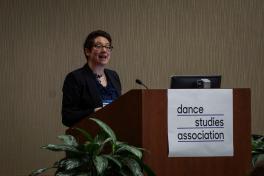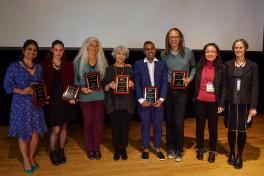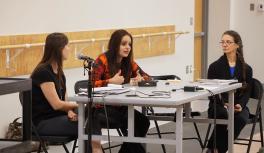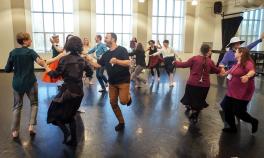By Assistant Professor Hannah Kosstrin

Sullivant Hall came alive with international dance research currents when The Ohio State University Department of Dance hosted the inaugural Dance Studies Association Conference Transmissions and Traces: Rendering Dance October 19–22, 2017. After holding joint conferences since 2013, the Congress on Research in Dance (CORD) and Society of Dance History Scholars (SDHS), the two largest international organizations for the field of dance studies, merged into the Dance Studies Association (DSA) in July 2017. DSA met at Ohio State under the leadership of President Anne Flynn (University of Calgary). With support from Ohio State departments and programs, the Department of Dance welcomed 450 dance scholars and researchers from across the field in the largest conference attendance since the organizations joined forces five years ago. The question that led the call for proposals, “How is dance transmitted?” represents our department’s research investments in scholarship, documentation, pedagogy, composition, and digital frameworks.

Led by Conference Chair (and DSA Treasurer) Hannah Kosstrin, Assistant Professor of Dance, the Local Arrangements Committee of Associate Professor Harmony Bench, Professor Karen Eliot, Professor Emerita Candace Feck, and Professor Susan Petry, supported by graduate students Kathryn Holt and Cole Garlando, along with Head of Thompson Special Collections Nena Couch, Lecturer Danielle Schoon, and Associate Dean Valarie Williams joined forces for almost three years to bring the conference to fruition. In conjunction with the tireless efforts of Ohio State Dance support staff Damian Bowerman, Carrie Cox, Oded Huberman, Deb Singer, and Chris Summers, and Dance Chair Susan Hadley, over fifty student and faculty volunteers kept the conference running smoothly all weekend.
Many Ohio State faculty, graduate students, and alumni presented research at the conference. Filling the Ohio Union and Sullivant Hall with paper panels, roundtable discussions, lecture-demonstrations, working groups, and movement workshops, dance scholars and researchers addressed where dance scholarship sits in the broader arena of dance transmission, with considerations of how dance might be tracked, or how it might be untraceable. Their presentations challenged common assumptions about the vestiges of dance, and less expected or less known ways that its traces manifest. They addressed these and other questions that arose from the call for proposals: By what corporeal and incorporeal means does dance extend its reach? In what ways do dance forms and practices travel, and what residues do they leave behind, marking the event of their passing? How and why might some dance forms resist working in more common modes of transmission, desiring to reach some audiences and not others? When is this a practice of resistance and when might it be a practice of maintaining hierarchies? What is transmitted through dance—what histories, legacies, cultural values, theories of the body, etc.? How does dance materialize and re-materialize in different contexts? How does pedagogy evolve? What is the role of legacy? What are the stakes of different forms of transmission, and who benefits from these different forms of circulation? Presenters discussed how dance transmission interacts with educational and presentational practices, and how efforts to document dance permeate the legibility of dance as a cultural phenomenon.

The opening plenary, keynote plenary, and Friday evening performance manifested the conference theme of Transmissions and Traces. The opening plenary, Rethinking Choreomusicology, honored the memory of dance historian and ethnomusicologist Julia Sutton, a founder of SDHS whose papers reside in Ohio State Special Collections. On the keynote plenary, Nadine George-Graves (University of California, San Diego) presented “Sugar Notes: Black Bodies, Trade, and Desire” and Judith Hamera (Princeton University) presented “Rehearsal Problems: Gus Giordano’s The Rehearsal, Canonicity, and the Place of the Local in Dance Studies.” Conference attendees had the opportunity to see Parallel Connections presented by BalletMet and Ohio State Dance in association with the Wexner Center for the Arts Friday evening, featuring choreography by Merce Cunningham, William Forsythe, James Kudelka, and Ohad Naharin.

2125 Stanley Street created and performed by Dahlia Nayar, Margaret Sunghe Paek, and Loren Kiyoshi Dempster, Dance Studies Association at Urban Arts Space, The Ohio State University, October 21, 2017. Performance made possible by generous donations from the Arts Initiative at Ohio State and by the New England Foundation for the Arts’ National Dance Project, with lead funding from the Doris Duke Charitable Foundation and The Andrew W. Mellon Foundation. Photo by Jess Cavender.

The DSA conference welcomed the Ohio State Urban Arts Space’s and the Melton Center for Jewish Studies’ campus and Columbus community members to various events during the weekend. We were pleased to partner with the Urban Arts Space, which opened its doors to conference attendees Saturday evening with a gallery reception and performance of New England Foundation for the Arts National Dance Project Touring Award artist Dahlia Nayar. The presentation of her work 2125 Stanley Street was made possible by the New England Foundation for the Arts’ National Dance Project, with lead funding from the Doris Duke Charitable Foundation and The Andrew W. Mellon Foundation. We were delighted that the Melton Center for Jewish Studies was a co-sponsor of the conference with support from the Thomas and Diann Mann Distinguished Symposium Fund. The Melton Center’s annual Mann Symposium was woven into the conference through three sessions on Sunday morning focusing on Jewish dance.

The DSA conference was made possible with support from departments and programs across campus and central Ohio. The Ohio State College of Arts and Sciences and Office of Research supported this endeavor through an Arts and Humanities Conference Support Larger Grant. Our colleagues in campus departments and centers including the Advanced Computing Center for the Arts and Design (ACCAD), the Arts Initiative, the Asian American Studies Program, Barnett Center for Integrated Arts and Enterprise, the Center for Slavic and East European Studies, Dancers in Graduate School, the Korean Performance Research Program, School of Music Musicology Area, and Departments of African American and African Studies, Comparative Studies, History of Art, Theatre, and Women’s, Gender, and Sexuality Studies, and the University of Dayton Department of Music and Theater, Dance, and Performance Technology Program joined in supporting our efforts. The Ohio State College of Arts and Sciences Technology Services supplied technical equipment to ensure we were all heard.
Transmissions and Traces placed Ohio State Dance prominently and proudly in the international spotlight of the field of dance studies and created opportunities for our graduate and undergraduate students to meet many of the researchers whose scholarship they know through their coursework. The dynamic presentations and conversations from the conference will ring through Sullivant Hall for months to come.
